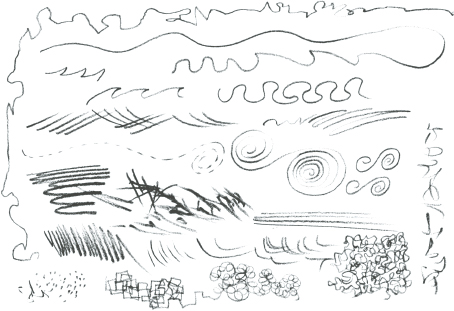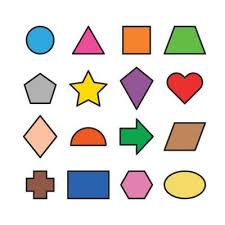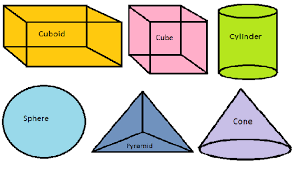Decathlon Art Terminology
1/48
There's no tags or description
Looks like no tags are added yet.
Name | Mastery | Learn | Test | Matching | Spaced |
|---|
No study sessions yet.
49 Terms
Line
The path of a point moving through space.
Length, width, direction
Hard or soft
Bold or indistinct
Uniform or varying in width
Can be implied with dots/lines
Vertical Lines: move the eye upward
Horizontal Lines: peace and tranquility
Jagged Lines: sense of activity

Shape
Two-dimensional area of an object.
Squares, circles, drawings
Represents real life figures

Form
Three-dimensional objects.
Length, width, depth
Cubes, spheres, sculpting
Can be portrayed in 2D art (shading)

Positive Space
The object, shape, or form itself.
Main figure/idea
Negative Space
Surrounding space, objects, and shapes.
Background character/scenery
Created through open space
Perspective
An illusion of depth.
Size of an object determined by its placement on a plane
Sense of volume and space
Color
Hues.
Local or optical
Warm or cool
Intensity
Visual/emotional effect
Creates space
Value
Lightness or darkness.
Sets atmosphere
Expressive quality
Neutrals
Black and white.
Grays created by mixing
Changes hue/intensity when added to color
Local Color
Color in normal lighting.
Ex. Grass in daylight
Real color and true tone
Optical Color
Color in special lighting.
Ex. Grass in nighttime
Lighting or mood
Arbitrary Color
Color chosen for artistic effect.
Ex. Red sky, blue grass
Emotional/aesthetic impact
Texture
Perceived surface quality.
Actual or visual
Ex. Bumpy, grainy
Feeling depth
adds shape
Composition
Organization of the elements.
Ex. Flower arrangements
Far or close
Fills or opens void
Contrast
Rhythm
Movement or pattern.
Heavier objects closer
Smaller objects farther
Sense of fulcrum balance
Motif/Pattern
Motif: single element of a pattern.
Pattern: repeating certain elements.
Ex. Quilt
Repetition
Decoration
Composition
Balance
Equal distribution of visual weight.
Ex. Folding paper in half
Ex. Column, wings, windows
Symmetry
Approximate Symmetry
Shapes/objects slightly varied on the central axis.
Different patterns filling the same space
Variation
Focal Point
Where the eye focuses/rests on the most.
Brings interest
Contrast
Visual appeal
Proportion
Size relationship to composition.
Ex. Basketball vs baseball
Accurate depiction
Disproportionate for emphasis
Scale
Dimensional relation or parts related to overall composition.
Ex. Sistine Chapel is massive
Intriguing
Contrast
Drawing
Basic of art practices.
Lines
Pencil, pen, ink
Textures
Sketching
Base
Shading Techniques
Hatching, crosshatching, stippling.
Illusion of 3D
Changes value
Density
Relief Printmaking
Cutting away parts of the plate and printing onto paper.
Ex. Carving into wood and rolling stamp ink over the surface
Dimension
Variety
Contrast
Intaglio Printmaking
Opposite of relief; lines carved into the surface.
Bank notes, passports, stamps
Engraving, etching
Shorter: fainter
Longer: deeper
Creates depth
Lithography
Surface drawn on with a wax tool and then ink is applied.
Oil and water
Easier than other printmaking techniques
Paint
Made of pigments, binders, and solvents.
Natural or synthetic
Powdered
Ground materials: clays gemstones, minerals
Binders: egg yolk, linseed oil, wax
Fresco
Technique used on walls or ceilings.
Powdered pigments and water applied to wet plaster ground
Murals
Permanent
Tempura
Water-based paint that can’t be blended once applied to the surface.
Narrow tone in range
Light or dark
Fast-drying
Long-lasting colors
Oil Painting Techniques
Glaze: semi-transparent layer
Impasto: Heavy lumps or paint applied quickly
Dries very slowly
Can alter colors
Transparent effect
Texture
Encaustic
Colored molten wax fused with the surface.
Grave markers
Long-lasting
Environmentally safer
Gouache
Water-based opaque paint.
Like tempura, but higher quality
Bright colors
More detail
Design and fine artwork
Watercolor
Water-based paint.
Most common
Lighter tint with more water
Must be planned precisely
Acrylic
Synthetic materials, plastics, and polymers.
All surfaces like wood, fabric, metal, etc.
Versatile
Decorative
Fast drying
Less detailed
Photography
Pictures in a scenic/artistic way.
People or scenes
Film and video
Artistic value
Symbolism
Composed and focused
Sculpture
Carving, modeling, casting, construction.
Clay, stone, marble
Freestanding or relief
Religious
Remembrance
Honor
Carving
Removing material.
Stone or wood
Chisels, hammers, files
Chiseling, gouging, shaping
Physical, 3D works
Modeling
Additive process formed by hand or simple tools.
Clay, wax, plaster, paper mache
Soft and workable
Cast Form
Form encased in a mold or plaster.
Unfired clay or wax
Plaster, metal, or resins
Identical clones
Environmental Art/Earthworks/Land Art
Changing nature to create large-scale constructed art on site.
Impermanent
Changes over time
Natural
Mixed Media
Using several art mediums to create one big art piece.
Ex. Collages
Fabric, rope, dishes, newspapers
Expressive
Incorporates all types of art forms
Performance Art
Performing in art form.
Acting, singing, dancing
Poems
Stylistic
Visual
Craft and Folk Art
Art forms across culture.
Pottery and jewelry
Fibers, glass, and wooden objects
Cultural
Community
Historical presence
Pottery
Based upon natural material from the ground.
Formed through a wheel, rolled coils, and assembly
Conventional items
Decorations
Fiber Arts
Woven and non-woven materials.
Weaving, looming, braiding, knitting, crocheting, quilting
Communicates messages
Emotional meaning
Post-and-lintel Construction
Stone or wooden beam placed horizontally across up-right posts.
Ex. Greek Parthenon
Structure and support
Roman Architectural Developments
Arches, vaults, and domes.
Ex. Colosseum
Concrete
Aqueducts, baths, public works
Greater interior space
Tall
Medieval Architectural Developments
Skeletal building style.
Buttresses
Thin walls
Stained-glass windows
Cathedrals
Greater lighting and color
Tall
Industrial Revolution Architectural Developments
Iron and steel building style.
Ex. Crystal Palace, Eiffel Tower
Reinforced concrete and bricks
Railways and bridges
Durability